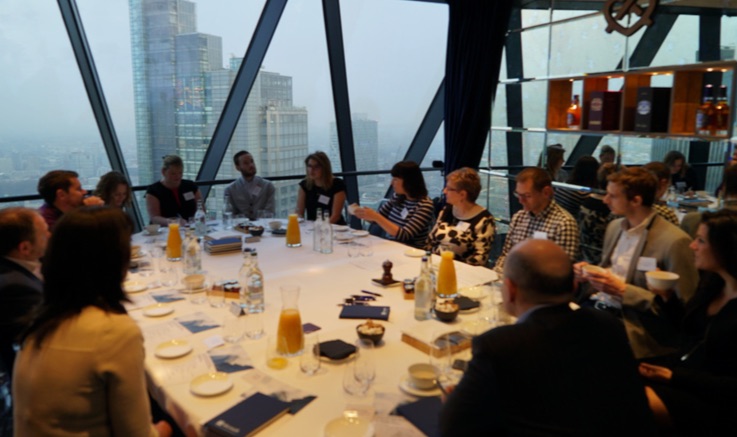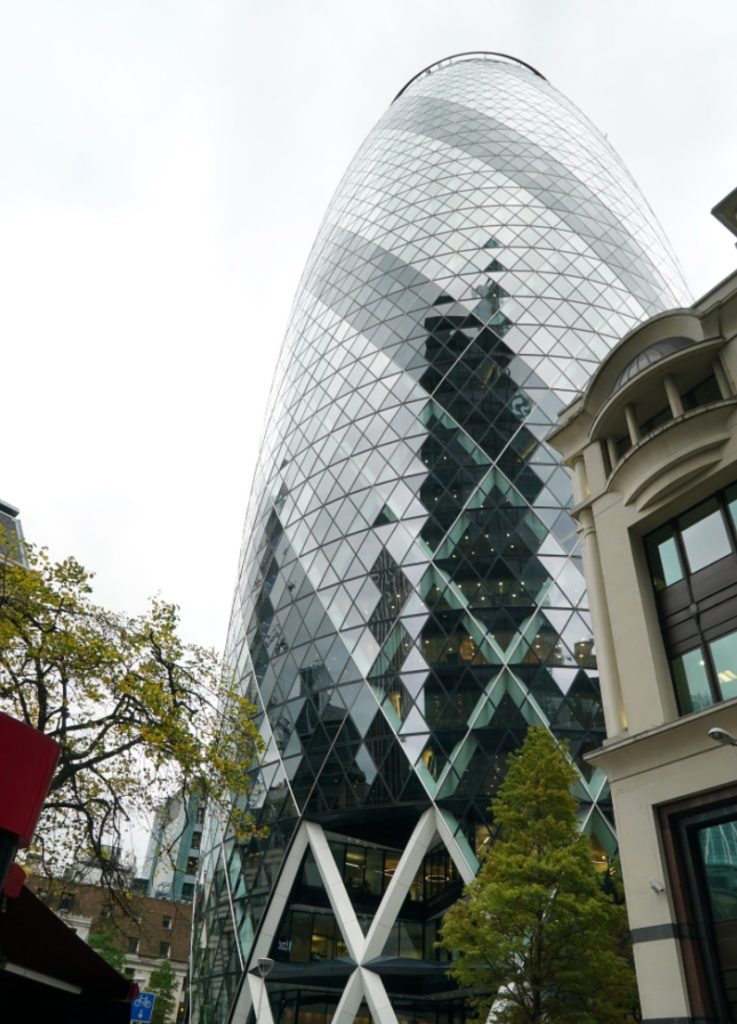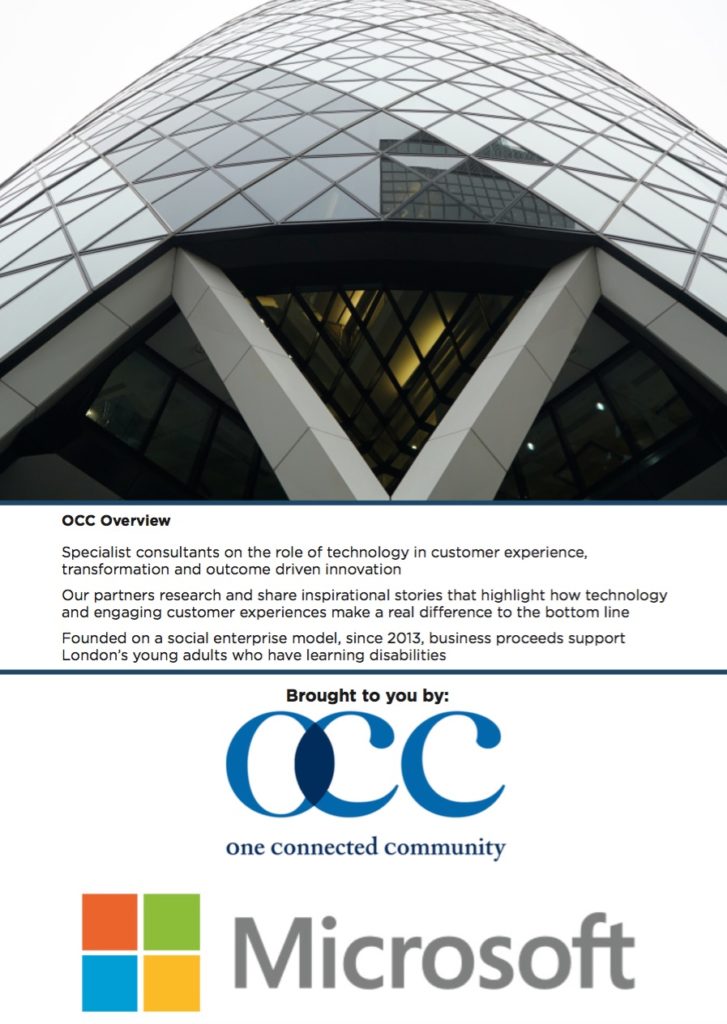I’m pleased to be able to share this illuminating report on a recent conference hosted jointly by OCC and Microsoft on the important question of ‘Omnichannel’ and how retailers can take advantage of many different channels to create the ideal customer experience.
This article, underlining the vital importance of organisational change, stakeholder engagement and customer focus in achieving technical innovation that is both lasting and successful, is nicely summed up in these quotes:
“How do we bring transformation to the boardroom? It’s not just a technology problem, it’s also a business one that we need to change.”
“Don’t just put digital everywhere for the sake of it. Technology investments must be based on core customer needs.”
I hope you find this article just as challenging and insightful as I did,
Mark

Introduction
When it comes to retail in 2017, a positive shopping experience is fundamental to attracting new customers, and engaging and retaining your loyal ones. Those retailers who offer customers a way to positively engage with their brands – seamlessly across mobile, online and the store – will set the foundation for customer loyalty and unlock the benefits that follow.
As Mike Lynskey, Retail Specialist, Microsoft, says: “The ability to reach customers in the most critical moments is what separates a run-of-the-mill retailer from a memorable one.”
Retailers recognise there has been a massive power switch to the customer and the need to deliver exceptional customer experience at every touchpoint has become more important than ever.
The term ‘omnichannel’ has been around for a while, but beneath all the hype lies a very serious proposition. In an age with countless customer channels, and where a customer journey will likely end on a different channel from where it begins, retailers must be able to stitch together all interactions to form one seamless customer experience.
To achieve effortless customer engagement, across digital and physical touchpoints, retailers need to instil a customer-first mindset across all teams and departments. Such a customer-centric approach will boost advocacy and loyalty, while ensuring innovation is measured accurately to generate a positive ROI.
But it’s easier said than done. It takes vision, incentives, technology and process – not to mention financial investment – to create an omnichannel utopia where everyone works together and pulls in the same direction.

How well are retailers responding to the growing demand for omnichannel shopping?
Last month, OCC and Microsoft hosted 20 top-level retailers at The Gherkin for a thought-provoking workshop dedicated to Omni-Channel on the inside: Customer first business models.
The session tackled retail’s big talking points:
- The people, process and technical transformation to meet customer demands
- How to remove “non-value adding activities”
- Data analytics and the next frontier of innovation
- Building effective partnerships to deliver a customer- led retail experience
“Everyone in the organisation should be obsessed with the customer.”
Mark Wright, Digital Managing Director, Jack Wills
As customers demand increasingly convenient and personalised ways to shop, the workshop represented a golden opportunity for retailers to share and discuss the necessary steps to improve the customer experience. Here we share the key talking points.
People, process and technology
Omnichannel is the idea that all the different channels offer the same customer experience, ensuring that a customer can start a journey on a mobile, reserve a product online, and purchase in-store – all with minimum effort.
As Mark Wright, Digital Managing Director, Jack Wills, says: “You must focus on who your customers are and how best you communicate with them.”
A growing number of today’s customers are happy to flip-flop between digital and physical touchpoints in this way. A typical shopping experience sees a customer research product reviews online, compare features with friends on social networks, reserve the product through an App, before picking it up in the local store.
But this presents a problem to many retailers, who haven’t necessarily been investing resources appropriately in the people, processes and technology to deliver seamlessly across touchpoints.
It’s a headache, says Fabrice Khullar, Lead Product Owner, Sainsbury’s: “The customer is far more complex than we give them credit for sometimes. Knowing where to place internal teams, so we deliver a united retail experience, is a real challenge.”
“It’s about the culture of making staff feel empowered.”
Paul Frost, Operations Development Manager, Sainsburys
The fundamental challenge is that retailers need to shift from product centric, to customer centric thinking. This demands the adoption of a new customer centric mindset across all departments – from eCommerce, to Operations, Sales, Customer Service and beyond. This alone is a huge mountain to climb as many teams are used to only thinking about one element of the customer journey (i.e. the much talked about silos within retailers).
As Alan Bateup, Senior Director, Digital Experience, McDonalds says: “Everyone in the organisation should be obsessed with the customer.”
While Fabrice Khullar, Lead Product Owner, Sainsbury’s says, in a market that is ever changing, the solution is organisational:
“We can’t predict the future, but all our old silos are killing us. We need to instil collaboration and cross-functional activity to be more agile and move with more flexibility. We can no longer build a business case purely in one team. We need to present cross-functional expertise as one piece of the puzzle rather than separately. Teams must start to build the business case together – there needs to be a mindset shift in the industry.”
Charles De Clerck, IT Customer Relationship Manager, Waitrose agrees. It all boils down to organisational structure, he says.
“Our major challenge has been recognising the importance of each, and every channel. It’s about joining-up eCommerce and store business at the board level. Because until you join them up, you’ll always have a fragmented experience.”
 As Alan Bateup, Senior Director, Digital Experience, McDonalds says: “Everyone in the organisation should be obsessed with the customer.”
As Alan Bateup, Senior Director, Digital Experience, McDonalds says: “Everyone in the organisation should be obsessed with the customer.”
While Fabrice Khullar, Lead Product Owner, Sainsbury’s says, in a market that is ever changing, the solution is organisational:
“We can’t predict the future, but all our old silos are killing us. We need to instil collaboration and cross-functional activity to be more agile and move with more flexibility. We can no longer build a business case purely in one team. We need to present cross-functional expertise as one piece of the puzzle rather than separately. Teams must start to build the business case together – there needs to be a mindset shift in the industry.”
Charles De Clerck, IT Customer Relationship Manager, Waitrose agrees. It all boils down to organisational structure, he says.
“Our major challenge has been recognising the importance of each, and every channel. It’s about joining-up eCommerce and store business at the board level. Because until you join them up, you’ll always have a fragmented experience.”
And it’s not just a challenge for the big supermarkets.
Establishing a customer-first mindset across the entire organisation is one of our biggest priorities, adds Anne Alderton, Business Development Manager, Marks and Spencer.
While Michel Koch, CMO, Time Inc. says: “It’s important to ask the eCommerce teams to regularly live a day in the life of a store manager, so they can understand the overall customer journey and look to translate that experience online.”
Boots stands-out as a success story when it comes to bridging cross-functional teams. Dave Robinson, Head of Loyalty & Personalisation, Boots, highlights the company’s unique approach to incentives and communication for overall business success.
“When an online order is collected in store, the sale is attributed to the store team, based on the customer postcode. This strategy has made a real difference to our broader culture.”
To fully embrace a customer centric approach then, retailers must adopt a complete omnichannel business strategy – externally and internally. To truly deliver faultless shopping experiences, it’s not just about being there across customer facing touch points, but re-evaluating how internal processes, communication and technology can better reflect modern customer expectations.
As Fabrice Khullar, Lead Product Owner, Sainsbury’s muses: “How do we bring transformation to the boardroom? It’s not just a technology problem, it’s also a business one that we need to change.”
In this sense, retailers must make sure there are clear, open and two-way channels of communication between the eCommerce Team, Store Team, Senior Management, Marketing, Analysts Content and Suppliers.
Without such open communication the struggle to win the customer will only grow. By managing certain key areas of communication you can enhance the customer experience even without new technology or additional resources.
In other words, to be customer-centric, you must first be employee-centric. Win the hearts and minds of staff by harmonising priorities and help to create an agile, innovative service culture across the entire organisation.
As Stuart Eames, Operational Improvement Manager, Waitrose, says: “The more you listen to your staff, the more you’ll move in the right direction.”
Learning how to effectively communicate your message will never go out of style. Agility is the key. An agile, customer centred strategy requires a cultural change across the organisation that emphasises lifetime value, the removal of “non-value adding” activity to spend what hours you do have serving the customer, outcome driven innovation and customer satisfaction as a core KPI.
To achieve this attitude shift, it is crucial that everyone; (a) must be aligned on the same performance targets and measures of success (to focus on what is right for the customer, not what is right for a specific P&L); and (b) be supported by the technology and data needed to provide contextual customer service (irrespective of touchpoint, or where they are on their journey.)
By breaking down silos, sharing information and creating a united vision in this way, staff at all levels will be empowered to deliver better service (which in the long run drives more revenues for the brand.)
Having witnessed huge success, Sonia Hudson, Head of People – Supply Chain and Wholesale, Morrisons, agrees.
“Listen hard and respond quickly is the mantra of our CEO. I’ve never worked in an organisation where someone has meant something so much. And, because we’ve got results from it, I think that makes it really stick!”
Paul Frost, Operations Development Manager, Sainsbury’s adds:
“It’s absolutely about the culture of making staff feel empowered. We must allow colleagues to do their job as friction-free as possible so that when they have a customer interaction they feel they have time to dedicate to that customer, rather than seeing it as something that’s getting in the way of the day job.”
Outside of groceries, fashion retailers identify similar findings. Mark Wright, Digital Managing Director, Jack Wills, says: “The key is empowering the front line and enabling innovation from the bottom-up because that’s where the great ideas are, and where people are more in touch with what’s going on”
It’s clear that to create a customer- first culture it requires buy-in at every level, from front line store staff, to the board room.
Non-value adding activities

Many retailers assume that their digital-savvy customers are the most proftable. This is largely due to a lower cost to serve and a greater opportunity to wow them through personalised content. Such a belief has led some to overinvest in digital channels so they can give customers (specifcally millennials) the digital experiences that they ‘crave.’ But this assumption is not entirely accurate.
Customers who see-saw between channels are in fact the most profitable. And these profitable customers don’t want purely digital interactions, they want experiences that deliver the results they seek using unpredictable combinations of digital and traditional channels.
John Lewis recently reported that shoppers who take advantage of its full omni-channel offering spend on average three times as much as people who are still using single channels for purchases – supposedly because the improved convenience encourages them to purchase more.
Dave Robinson, Head of Loyalty & Personalisation, Boots, shares similar findings: “Our omnichannel customers are worth-up to four times life-long value, compared to a single channel customer.”
In this light, it’s all about the need to focus on meeting customers’ needs, looking at what is best for them, rather than letting technology solutions dictate the overall strategy.
Customer first, not technology first. Allow digital to seep into the business only where benefits are clear. Do not innovate for innovation’s sake, but rather think about what’s useful for your customers. There must be a solid business case first. Think about the experience you’re trying to deliver, and how that aligns with your brand and strategy.
Our group stresses the risk of technical investment without real justification.
As Sarah Jones, International Omnichannel Manager, Body Shop, says: “Don’t just put digital everywhere for the sake of it. Technology investments must be based on core customer needs.”
“It’s about how people engage with your brand, rather than where they are at a specific time” adds Mark Wright, Digital Managing Director, Jack Wills.
Design with the customer in mind, says Alan Bateup, Senior Director, Digital Experience, McDonalds.
“It’s important to understand the journey. Technology must solve a real problem. Start with the problem that you are trying to solve, and then think about what technology is the best way to solve that problem. It’s not about one solution, it’s about continuous improvement.”
Looking to the future, the group agrees that it is important to arm staff with enough information to provide relevant experiences for each, and every customer. In the grocery sector this could take the form of a multi-functional device, says Stuart Eames, Operational Improvement Manager, Waitrose.
“How do we make it so our staff have the information and ability to do their jobs? A multifunctional device, that allows for stock checks and to place orders online for instance, would allow store colleagues to do everything from one handset. In this way, every-time a customer interacts with our staff, they should be able to deal with them from that location (and not waste time).”
Partnerships
Ensuring consistency of message is fundamental to providing good customer experience. To achieve consistency, it’s crucial to shift thinking to a customer-first strategy, supported by leaders who foster a culture able to change and drive innovation.
Our group highlights that culture is not a one-off project, but something that constantly evolves over the years.
 It is very much part of the culture to have the right people that care and to recognise the good things people do. As Alan Bateup, Senior Director, Digital Experience, McDonalds says: “It’s not just about the latest technical skills or retail experience, but how you act within the culture of the organisation.”
It is very much part of the culture to have the right people that care and to recognise the good things people do. As Alan Bateup, Senior Director, Digital Experience, McDonalds says: “It’s not just about the latest technical skills or retail experience, but how you act within the culture of the organisation.”
It is also about having the ability to abandon what you are doing if it is not right. As Mark Wright, Digital Managing Director, Jack Wills, recalls:
“Two or three months into the role I made what I thought could be a career killing decision – to cut the App. It served no valuable purpose, it was ripping- off the mobile site, the conversion was poor and I needed a way to give my team more time to focus on where I thought we could really drive value.”
Dave Robinson, Head of Loyalty & Personalisation, Boots, agrees: “Don’t just do the shiny bits that people see, invest in the staff and backend technology to see the results you need.”
Charles De Clerck, IT Customer Relationship Manager, Waitrose, adds:
“As an industry, our front end systems, i.e. website and mobile technology is getting there. But the key to all this is the back end systems, i.e. the supply chain and transport management. It’s the expensive big legacy systems that ultimately help you fulfil your customer promise. Everyone forgets about these systems because it’s not the ‘sexy stuff.’ Investment in these systems is massively transformational to the business, but nobody yet has been brave enough to bite the bullet.”
“The technology has advanced enough, but our businesses haven’t advanced enough to adopt them and make the big investments.”
Fabrice Khullar, Lead Product Owner, Sainsbury’s agrees. “It’s all about investment in the legacy systems that we’ve all ignored for decades.”
But retailers are wary, says David Merricks, Food Supply Chain Development Manager, Marks & Spencer. “Whether its front end or back end systems these things require significant amounts of capital, and traditional retailers are still wary to spend that amount of money when there’s no immediate return on value.”
Foster an inclusive atmosphere, says Michel Koch, CMO, Time Inc. “We’re all in this together. Focusing on the customer is the right thing to do. Forming your strategy and your decisions with the customer in mind is vital. And, reflective of a start-up, informing all your staff of your decisions, will create real results.”
“If you make it simple and intuitive, customers will use it.”
Anne Alderton, Business Development Manager, Marks & Spencer
Several retailers encourage their staff to come forward with ideas and promote new ways of thinking through cross-functional groups.
As Stuart Eames, Operational Improvement Manager, Waitrose, says: “We’ve introduced a Site Point of Contact (SPOC) in every branch to provide feedback around any new proposition, and how it works for customers and staff. It’s proving to be a really powerful tool.”
Data & Innovation
Data is transforming every industry, but it’s having a big impact on retail. Customer data and insights is a treasure trove of information that can be put to good use ensuring that optimum customer journeys are aligned to work flows, structures and given marketing campaigns.
Retail can no longer be a little bit digital. It’s important to remember that customers view services holistically and not through the lens of individual interactions or touchpoints.
As Claire Gillingham, HR Director, Vodafone, says: “We don’t call it omnichannel anymore, we call it one channel, because that’s the way customers see it.”
So, to make the most of data you must connect all relevant teams (from sales, to social, marketing and IT) at an early stage and outline the value and purpose.
The difficult questions retailers face include:
- How much information?
- What format do you provide it to customers to deliver best results?
- How to mitigate information overload and appearing overly personal?
- Who owns customer data internally and how is this shared?
As Sonia Hudson, Head of People – Supply Chain and Wholesale, Morrisons says: “It’s all about how best to join-up of the channels and different data sets to deliver overall business success.”
Having accurate, timely and available data about how your customers respond to features and attractions in-store, on mobile or online, can hugely help the whole business focus on what works, and what doesn’t.
As Charles De Clerck, IT Customer Relationship Manager, Waitrose says: “Make IT a strategic priority at all levels, and help everyone to understand the real value of customer data to best exploit it. It’s all about the outside-in approach. Don’t focus on the latest and greatest technology, but actually focus on the customer problems that you’re trying to solve, and where does technology/data add value, and where does it not.”
But there is a balance to be struck. It’s all about using data in the right way, says Kirrie Kendall, Head of Internal Communication, Dixons Carphone.
“It’s about identifying that sweet spot, where you’re using data, but you’re not letting it absolutely dictate and drive all decisions.”
Mark Wright, Digital Managing Director, Jack Wills, agrees. “Common sense is often one of the most important data sources.”
Conclusions
Omnichannel opens a whole new level of doing business, by putting the customer and technology in the centre of their strategy, retailers can collect the data, learn to understand their customers better, deliver more relevant content and measure an increase in ROI – across all channels.
With the rising number of channels and touchpoints, it’s difficult to keep up in a hype-neutral way, so, prudently, our retailers are focusing on striking a balance between innovation and proven ways of doing business.
The business case for omnichannel is such that organisations the world over will increasingly be exploring how they can better serve the omnichannel customer in the coming years. Early adopters are already seeing signicant benefits – with their efforts to support omnichannel customers delivering real commercial returns.
The business case is simple. To remain competitive, retailers must respond to the demands of the customer. Shoppers now expect to have the same level of service when they purchase an item in store as when they make a purchase online.
It’s clear that many of our retailers are placing the customer at the heart of what they do, as they continue their journey of transformation.
If you are a retailer, technology is not your enemy. It gives you the invaluable opportunity to deliver powerful and meaningful customer experiences. But focus on the problem you want to solve for your customer, rather than the shiny technology just for the sake of it.
No doubt retailers are under pressure. Digitised customers have ever-higher expectations of service and the retail experience. Today optimising customer experience across all channels should be a priority that colours the entire brand. The number one challenge for retailers is to understand the real value of digital investment (frontend and backend) and to deliver customer-centric thinking across the entire organisation.
But for a retailer to adopt a large-scale digital strategy, it needs to clearly understand how it will enable better connections with customers, leading to improved targeting and communications that deliver increased sales.
Shoppers expect retailers to deliver an amazing customer experience – compelling yet easy – across all stages of the customer journey. It’s no longer about online and store sales competing – but bringing the two channels together, to create flawless, enjoyable customer journeys that promote purchases (either in-store or remotely). But establishing a customer- first mantra is difficult. It’s all about taking the theory of putting the customer at the centre and making it a reality for the business.
Focus on what the customer wants. Customers should be seen as guests invited to a party, where you are the host. It’s your job every day to make every important aspect of the customer experience a little bit better.
In the next five years, they say retail will change more than in the past fifty. Now is the time to think and act differently. But once you’re started on the customer-centric journey, be prepared to make continuous investment and change.

